1994 PONTIAC GRAND-AM engine
[x] Cancel search: enginePage 221 of 274

Service & Appearance Care
Normal Maintenance Replacement Parts
Air Cleaner Element
2.3L Quad OHC and Quad 4 ....................
3.lLV6 ....................................
Engine Oil Filter
2.3L Quad OHC and Quad 4 ....................
3.1LV6 ....................................
PCV Valve
3.1LV6 ....................................
Spark Plugs
2.3L Quad OHC ..............................
2.3L Quad DOHC with Automatic Transaxle .......
2.3L Quad DOHC with Manual Transaxle .........
2.3L Quad High Output ........................
3.1LV6 ....................................
AC Type A- 1233C
AC Type A-1233C
AC Type PF- 1225
AC Type PF-40
or AC Type PF-47
AC Type 892C
AC Type 041-603
Gap: 0.035 inch (.889 mm)
AC Type 04 1-603
Gap: 0.035 inch (.889
mm)
AC Type 041-602
Gap: 0.035 inch (389 mm)
AC Type 04 1-602
Gap: 0.035 inch
(.889 mm)
AC Type R44 LT SM6
Gap: 0.060 inch (1.52 mm)
... 220
ProCarManuals.com
Page 226 of 274
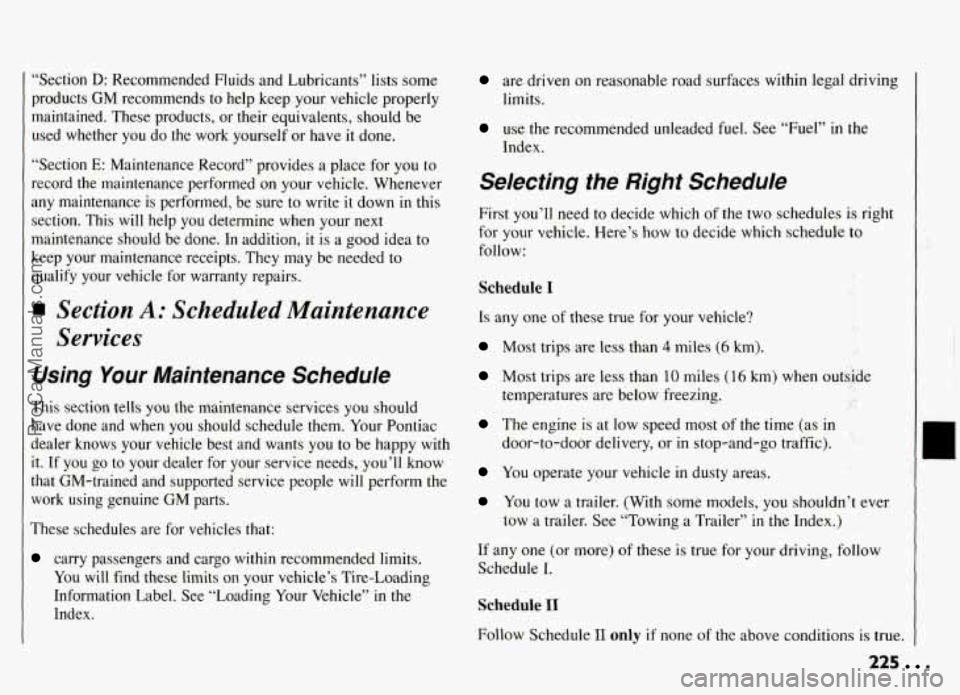
“Section D: Recommended Fluids and Lubricants” lists some
products
GM recommends to help keep your vehicle properly
maintained. These products,
or their equivalents, should be
used whether you do the work yourself or have it done.
‘Section E: Maintenance Record” provides a place for you to
record the maintenance performed on your vehicle. Whenever
any maintenance is performed,
be sure to write it down in this
section. This will help you determine when your next
maintenance should be done. In addition, it
is a good idea to
keep your maintenance receipts. They may be needed to
qualify your vehicle for warranty repairs.
Section A: Scheduled Maintenance
Sewices
Using Your Maintenance Schedule
This section tells you the maintenance services you should
have done and when you should schedule them.
Your Pontiac
dealer knows your vehicle best and wants you to be happy with
it. If you
go to your dealer for your service needs, you’ll know
that GM-trained and supported service people will perform the
work using genuine
GM parts.
These schedules are for vehicles that:
carry passengers and cargo within recommended limits.
You will find these limits on your vehicle’s Tire-Loading
Information Label. S’ee “Loading Your Vehicle” in the
Index.
are driven on reasonable road surfaces within legal driving
limits.
use the recommended unleaded fuel. See “Fuel” in the
Index.
Selecting the Right Schedule
First you’ll need to decide which of the two schedules is right
for your vehicle. Here’s how to decide which schedule to
follow:
Schedule I
Is any one of these true for your vehicle?
Most trips are less than 4 miles (6 km).
Most trips are less than 10 miles (16 km) when outside
temperatures are below freezing.
The engine is at low speed most of the time (as in
door-to-door delivery, or in stop-and-go traffic).
You operate your vehicle in dusty areas.
You tow a trailer. (With some models, you shouldn’t ever
tow a trailer. See “Towing a Trailer” in the Index.)
If any one (or more) of these is true for your driving, follow
Schedule I.
Schedule I1
Follow Schedule I1 only if none of the above conditions is true.
225
ProCarManuals.com
Page 229 of 274
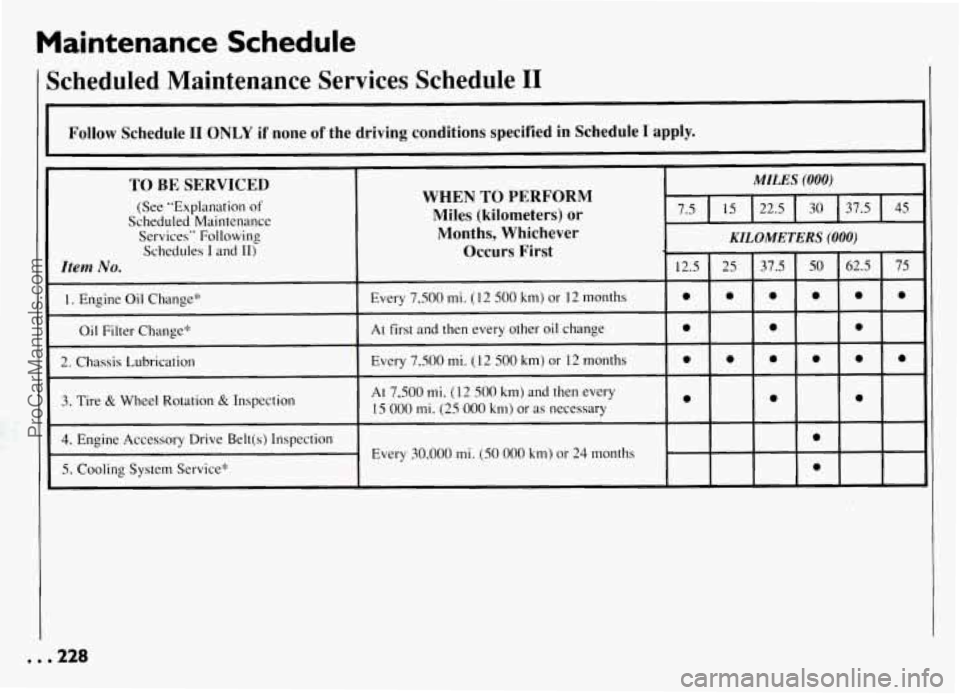
Maintenance Schedule
Scheduled Maintenance Services Schedule I1
Follow Schedule I1 ONLY if none of the driving conditions specified in Schedule I apply.
I
TO BE SERVICED
(See "Explanation of
Scheduled Maintenance Services" Following Miles (kilometers) or
Months, Whichever
KILOMETERS (000)
MILES (000)
WHEN TO PERFORM
Schedules I and 11,- Occurs First
Item No. 37.5 25
12.5
1. Engine Oil Change" Every
7,500 mi. ( 12 500 km) or 12 months
0,il Filter Change"
2. Chassis Lubrication At
first and then every other oil change
Every 7,500 mi. (12
500 km) or 12 months
0 0 0
0 0
0 0
0
3. Tire & Wheel Rotation & Inspection
4. Engine Accessory Drive Belt(s) Inspection
5. Cooling System Service*
At 7,500 mi. ( 12 500 km) and then every
15
000 mi. (25 000 km) or as necessary 0 0
Every 30.000 mi. (50 000 km) or 24 months
!
+
50 62.5
1
I
I.
t
. . .22a
ProCarManuals.com
Page 230 of 274
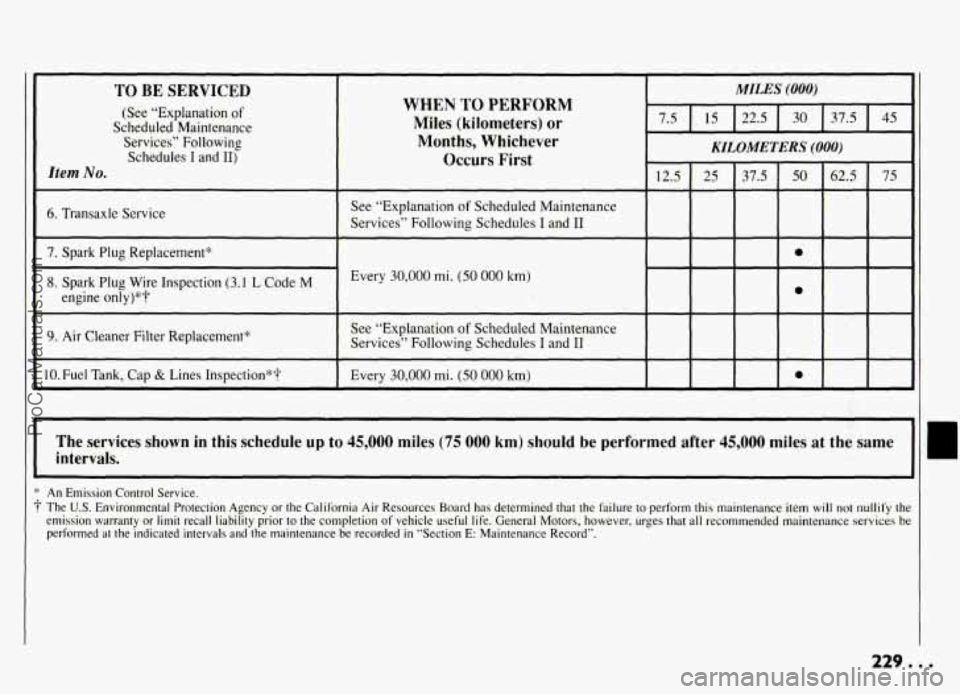
TO BE SERVICED
(See “Explanation of
Scheduled Maintenance
Services” Following
Schedules I and 11)
Item No.
6. Transaxle Service
7. Spark Plug Replacement*
8. Spark Plug Wire Inspection (3.1 L Code M
engine only)*?
9. Air Cleaner Filter Replacement”
10.Fuel Tank, Cap
& Lines Inspection*?’
WHEN TO PERFORM
Miles (kilometers) or
Months, Whichever
Occurs First
See “Explanation of Scheduled Maintenance
Services” Following Schedules
I and I1
Every 30,000 mi. (50 000 km)
See “Explanation of Scheduled Maintenance
Services” Following Schedules I and I1
Every
30,000 mi. (50 000 km)
MILES (000)
KILOMETERS (000)
The services shown in this schedule up to 45,000 miles (75 000 km) should be performed after 45,000 miles at the same
intervals.
I
* An Emission Control Service.
? The U.S. Environmental Protection Agency or the California Air Resources Board has determined that the failure to perform this maintenance item will not nullify the
emission warranty or limit recall liability prior to the completion of vehicle useful life. General Motors, however, urges that all recommended maintenance services be
performed at the indicated intervals and the maintenance be recorded in “Section E: Maintenance Record”.
ProCarManuals.com
Page 231 of 274
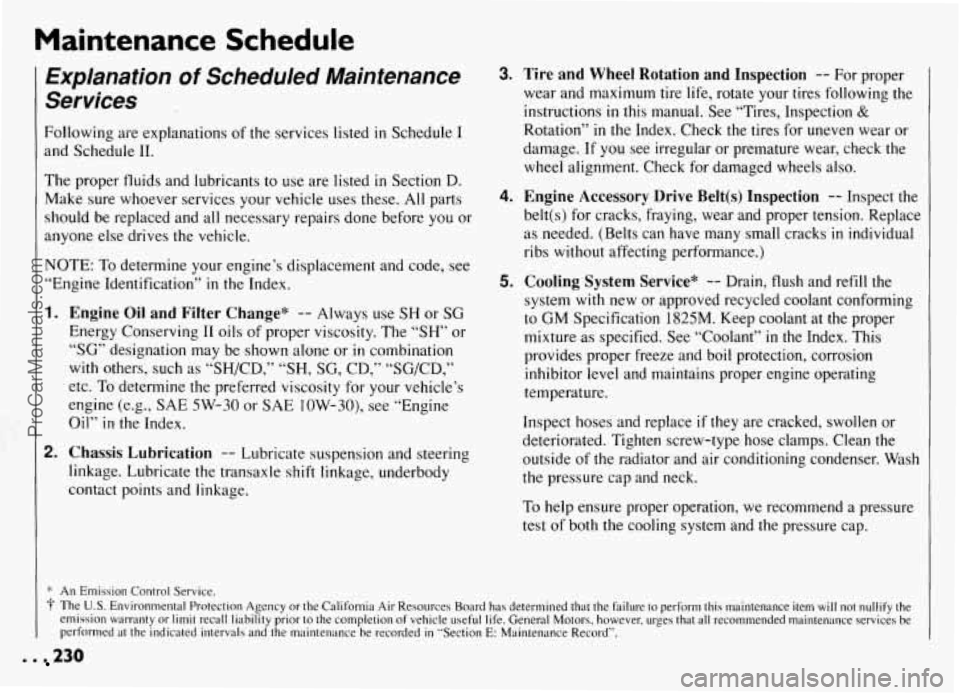
Maintenance Schedule
Explanation of Scheduled Maintenance
Services
Following are explanations of the services listed in Schedule I
and Schedule 11.
The proper fluids and lubricants to use are listed in Section D.
Make sure whoever services your vehicle uses these. All parts
should be replaced and all necessary repairs done before you or
anyone else drives the vehicle.
NOTE: To determine your engine’s displacement and code, see
“Engine Identification”
in the Index.
1.
2.
Engine Oil and Filter Change* -- Always use SH or SG
Energy Conserving I1 oils of proper viscosity. The “SH” or
“SG” designation may be shown alone or in combination
with others, such as “SH/CD,” “SH, SG, CD,” “SG/CD,”
etc. To determine the preferred viscosity for your vehicle’s
engine (e.g., SAE 5W-30 or SAE 10W-30), see “Engine
Oil”
in the Index.
Chassis Lubrication -- Lubricate suspension and steering
linkage. Lubricate the transaxle shift linkage, underbody
contact points and linkage.
3.
4.
5.
Tire and Wheel Rotation and Inspection -- For proper
wear and maximum tire life, rotate your tires following the
instructions
in this manual. See “Tires, Inspection &
Rotation” in the Index. Check the tires for uneven wear or
damage. If you see irregular or premature wear, check the
wheel alignment, Check for damaged wheels also.
Engine Accessory Drive Belt(s) Inspection -- Inspect the
belt(s) for cracks, fraying, wear and proper tension. Replace
as needed. (Belts can have many small cracks
in individual
ribs without affecting performance.)
Cooling System Service* -- Drain, flush and refill the
system with new or approved recycled coolant conforming
to
GM Specification 1825M. Keep coolant at the proper
mixture as specified. See “Coolant”
in the Index. This
provides proper freeze and boil protection, corrosion
inhibitor level and maintains proper engine operating
temperature.
Inspect hoses and replace if they are cracked, swollen or
deteriorated. Tighten screw-type hose clamps. Clean the
outside of the radiator and air conditioning condenser. Wash
the pressure cap and neck.
To help ensure proper operation, we recommend a pressure
test of both the cooling system and the pressure cap.
. . 230
ProCarManuals.com
Page 232 of 274

6. Transaxle Service -- For manual transaxles, fluid doesn’t
require changing. See “Periodic Maintenance Inspections.”
For automatic transaxles, change both the fluid and filter
every
15,000 miles (25 000 km) if the vehicle is mainly
driven under one or more of these conditions:
* In heavy city traffic where the outside temperature
regularly reaches 90°F (32°C) or higher.
0 In hilly or mountainous terrain.
0 When doing frequent trailer towing.
0 Uses such as found in taxi, police car or delivery
service.
If you -do not use your vehicle under any of these
conditions, change both the fluid and filter every
100,000 miles ( 166 000 km).
7. Spark Plug Replacement* -- Replace spark plugs with
the proper type. See “Replacement Parts” in the Index.
8. Spark Plug Wire Inspection (3.1L Code M engine
only)*?
-- Inspect for burns, cracks or other damage.
Check
the boot fit at the coils and at the spark plugs.
Replace wires as needed.
9. Air Cleaner Filter Replacement* -- Replace every
30,000 miles (50 000 km) or more often under dusty
conditions.
Ask your dealer for the proper replacement
intervals for your driving conditions.
1 O.Fuel Tank, Cap and Lines Inspection”? -- Inspect fuel
tank, cap and
lines (including fuel rails and injection
assembly) for damage or leaks. Inspect
fuel cap gasket for
an even filler neck imprint or any damage. Replace parts as
needed. Periodic replacement of the fuel filter is
not
required.
* An Emission Control Service.
3- The U.S. Environmental Protection Agency or the California Air Resources Board has determined that the failure to perform this maintenance item will not nullify the
emission warranty or limit recall liability prior to the completion of vehicle useful life. General Motors, however, urges that all recommended maintenance services be performed at the indicated intervals and the maintenance be recorded in “Section E: Maintenance Record”.
ProCarManuals.com
Page 233 of 274
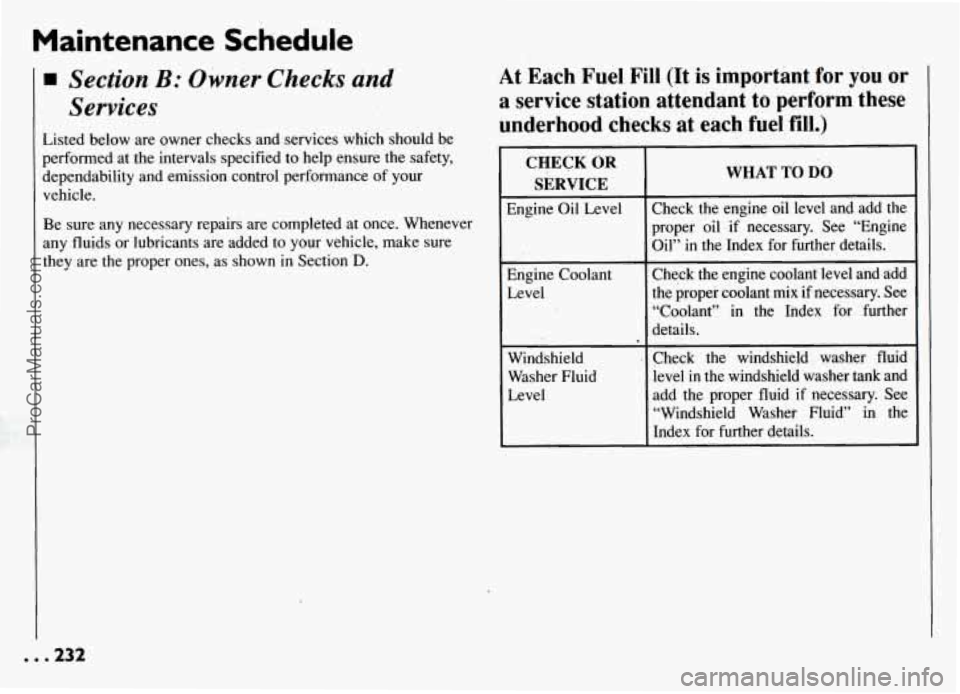
Maintenance Schedule
Section B: Owner Checks and
Services
Listed below are owner checks and services which should be
performed at the intervals specified to help ensure the safety,
dependability and emission control performance of your
vehicle.
Be sure any necessary repairs are completed at once. Whenever
any fluids or lubricants are added to your vehicle, make sure
they are the proper ones, as shown in Section
D.
At Each Fuel Fill (It is important for you or
a service station attendant to perform these
underhood checks at each fuel fill.)
CHECK OR
SERVICE
Engine Oil Level
Engine Coolant
Level
Windshield
Washer Fluid
Level
WHAT TO DO
Check the engine oil level and add the
proper oil
if necessary. See “Engine
Oil”
in the Index for further details.
Check the engine coolant level and add
the proper coolant mix if necessary. See
“Coolant” in the Index for further
details.
Check the windshield washer fluid
level in the windshield washer tank and
add the proper fluid
if necessary. See
“Windshield Washer Fluid” in the
Index for further details.
ProCarManuals.com
Page 235 of 274
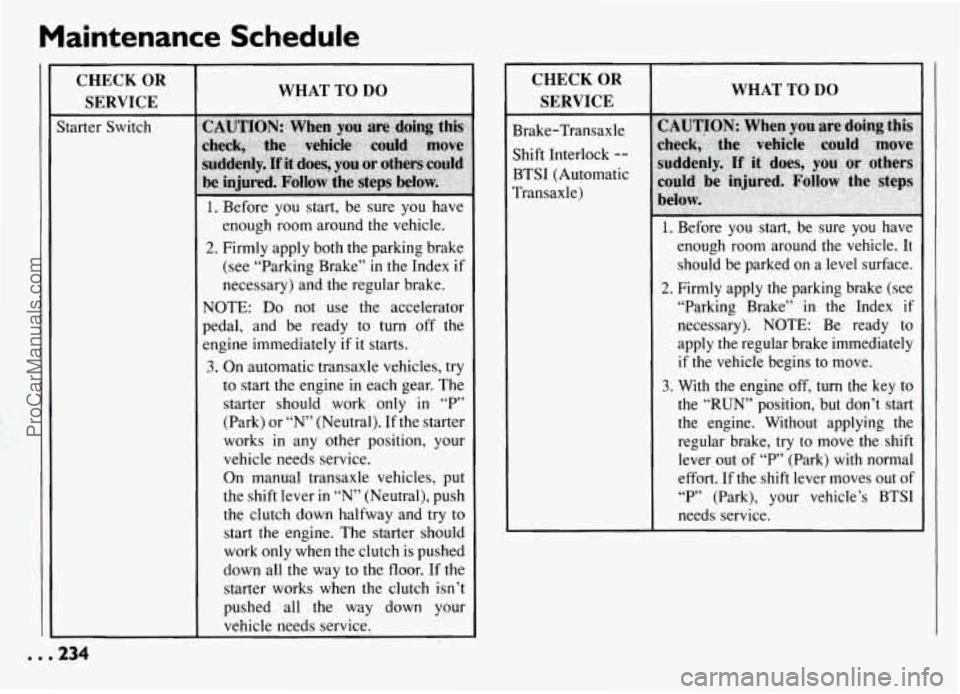
Maintenance Schedule
CHECK OR
SERVICE
Starter Switch
WHAT TO DO
1. Before you start, be sure’ you have
enough room around the vehicle.
2. Firmly apply both the parking brake
(see “Parking Brake” in the Index if
necessary) and the regular brake.
NOTE: Do not use the accelerator
pedal, and be ready to turn off the
engine immediately if it starts.
3. On automatic transaxle vehicles, try
to start the engine in each gear. The
starter should work only
in “F’”
(Park) or “N” (Neutral). If the starter
works
in any other position, your
vehicle needs service.
On manual transaxle vehicles, put
the shift lever in “N” (Neutral), push
the clutch down halfway and
try to
start the engine. The starter should
work only when the clutch is pushed
down all the way to ‘the floor. If the
starter works when the clutch isn’t
pushed all the way down your
vehicle needs service.
CHECK OR
SERVICE
Brake-Transaxle
Shift Interlock
--
BTSI (Automatic
I‘ransaxle)
WHAT TO DO
1. Before you start, be sure you have
enough room around the vehicle. It
should be parked on a level surface.
2. Firmly apply the parking brake (see
“Parking Brake”
in the Index if
necessary). NOTE: Be ready to
apply the regular brake immediately
if the vehicle begins to move.
3. With the engine off, turn the key to
the “RUN” position, but don’t start the engine. Without applying the
regular brake, try to move the shift
lever out of
“P” (Park) with normal
effort. If the shift lever moves out of
“P’ (Park), your vehicle’s BTSI
needs service.
. . .234
ProCarManuals.com